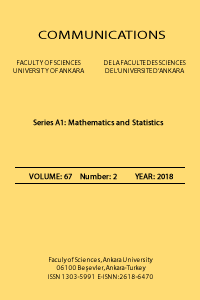GLOBAL STABILITY FOR A HIV/AIDS MODEL
___
- U. L. Abbas, R. M. Anderson and J. W. Mellors, Potential Impact of Antiretroviral Chemo- prophylaxis on HIV-1 Transmission in Resource-Limited Settings, PLoS ONE 2 (2007), e875. [2] R. M. Anderson, The role of mathematical models in the study of HIV transmission and the epidemiology of AIDS J. AIDS 1 (1988), 241–256.
- R. M. Anderson, G. F. Medley, R. M. May and A. M. Johnson, A Preliminary Study of the Transmission Dynamics of the Human Immunode…ciency Virus (HIV), the Causative Agent of AIDS, IMA J. Math. Appl. Med. and Biol. 3 (1986), 229–263.
- S. M. Blower, D. Hartel, H. Dowlatabadi, R. M. Anderson and R. M. May, Drugs, Sex and HIV: A Mathematical Model for New York City, Phil. Trans. R. Soc. Lond. B 321 (1991), 171–187.
- L. Cai, X. Li, M. Ghosh and B. Guo, Stability analysis of an HIV/AIDS epidemic model with treatment, Journal of Computational and Applied Mathematics 229 (2009), 313–323.
- P. W. David, G. L. Matthew, E. G. Andrew, A. C. David and M. K. John, Relation between HIV viral load and infectiousness: A model-based analysis, The Lancet 372 (2008), no. 9635, 314–320.
- S. G. Deeks, S. R. Lewin and D. V. Havlir, The end of AIDS: HIV infection as a chronic disease, The Lancet, 382 (2013), no. 9903, 1525–1533.
- R. Denysiuk, C. J. Silva and D. F. M. Torres, Multiobjective approach to optimal control for a tuberculosis model, Optim. Methods Softw. 30 (2015), no. 5, 893–910.
- H. Hai-Feng, C. Rui and W. Xun-Yang, Modelling and stability of HIV/AIDS epidemic model with treatment, Applied Mathematical Modelling 40 (2016), 6550–6559.
- H. W. Hethcote, The mathematics of infectious diseases, SIAM Rev. 42 (2000), 599–653.
- H. W. Hethcote and J. W. Van Ark, Modeling HIV Transmission and AIDS in the United States, Lecture notes in Biomathematics, Springer-Verlag, New York, 1992.
- H. Huo and L. Feng, Global stability for an HIV/AIDS epidemic model with diğ erent latent stages and treatment, Applied Mathematical Modelling 37 (2013), 1480–1489.
- J. M. Hyman and E. A. Stanley, Using mathematical models to understand the AIDS epi- demic, Mathematical Biosciences 90 (1988), 415–473.
- V. Lakshmikantham, S. Leela and A. A. Martynyuk, Stability Analysis of Nonlinear Systems, Marcel Dekker, Inc., New York and Basel, 1989.
- J. P. LaSalle, The Stability of Dynamical Systems, in: Regional Conferences Series in Applied Mathematics, SIAM, Philadelphia, 1976.
- J. Li, Y. Yanga and Y. Zhoub, Global stability of an epidemic model with latent stage and vaccination Nonlinear Analysis: Real World Applications 12 (2011), 2163–2173.
- Z. Mukandavire and W. Garirar, Eğ ect of Public Health Educational Campaigns and the Role of Sex Workers on the Spread of HIV/AIDS among Heterosexuals, Theoretical Population Biology 72 (2007), 346–365.
- R. Naresh, A. Tripathi and S. Omar, Modelling the spread of AIDS epidemic with vertical transmission, Applied Mathematics and Computation 178 (2006), 262–272
- F. Nyabadza, Z. Mukandavire and S. D. Hove-Musekwa, Modelling the HIV/AIDS epidemic trends in South Africa: Insights from a simple mathematical model, Nonlinear Anal. Real World Appl. 12 (2011), 2091–2104.
- A. Rachah and D. F. M. Torres, Mathematical modelling, simulation, and optimal control of the 2014 Ebola outbreak in West Africa, Discrete Dyn. Nat. Soc. 2015 (2015), Art. ID 842792, 9 pp.
- H. S. Rodrigues, M. T. T. Monteiro and D. F. M. Torres, Vaccination models and optimal control strategies to dengue, Math. Biosci. 247 (2014), 1–12.
- A. Sani, D. P. Kroese and P. K. Pollet, Stochastic Models for the Spread of HIV in a Mobile Heterosexual Population, Math Biosc 208 (2007), 98–124.
- D. Sharma, Modelling and analysis of the spread of AIDS epidemic with immigration of HIV infectives, Mathematical and Computer Modelling 49 (2009), 880–892.
- C. J. Silva and D. F. M. Torres, A TB-HIV/AIDS coinfection model and optimal control treatment, Discrete Contin. Dyn. Syst. 35 (2015), no. 9, 4639–4663.
- A. Tripathi, R. Naresh and D. Sharma, Modelling the eğ ect of screening of unaware infectives on the spread of HIV infection, Applied Mathematics and Computation 184 (2007), 1053– 1068.
- ISSN: 1303-5991
- Yayın Aralığı: Yılda 4 Sayı
- Başlangıç: 1948
- Yayıncı: Ankara Üniversitesi
STRONGLY -CLEAN PROPERTIES AND RINGS OF FUNCTIONS
Huanyin CHEN, Abdullah HARMANCI
GENERALIZED FRACTIONAL HERMITE-HADAMARD TYPE INEQUALITIES FORm CONVEX AND ( ; m) CONVEX FUNCTIONS
ABUNDANCE OF EQUIVALENT NORMS ONc0WITH FIXED POINT PROPERTY FOR AFFINE NONEXPANSIVE MAPPINGS
J. SILVA CRİSTİANA, M. TORRES DELFIM F.
INEXTENSIBLE FLOW OF A SEMI-REAL QUATERNIONIC CURVE IN SEMI-EUCLIDEAN SPACE
